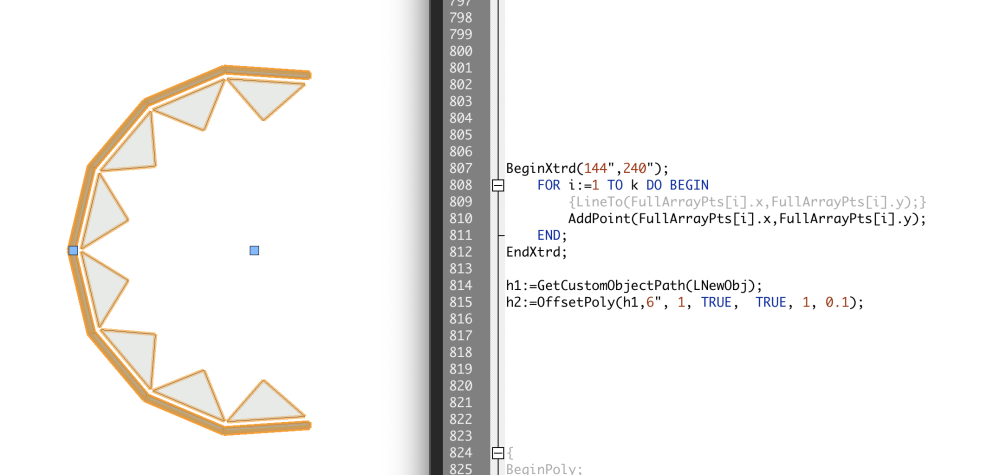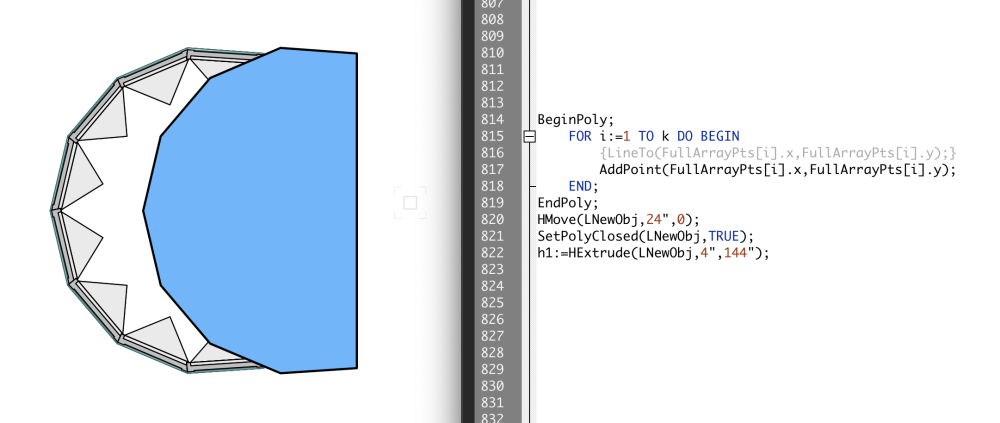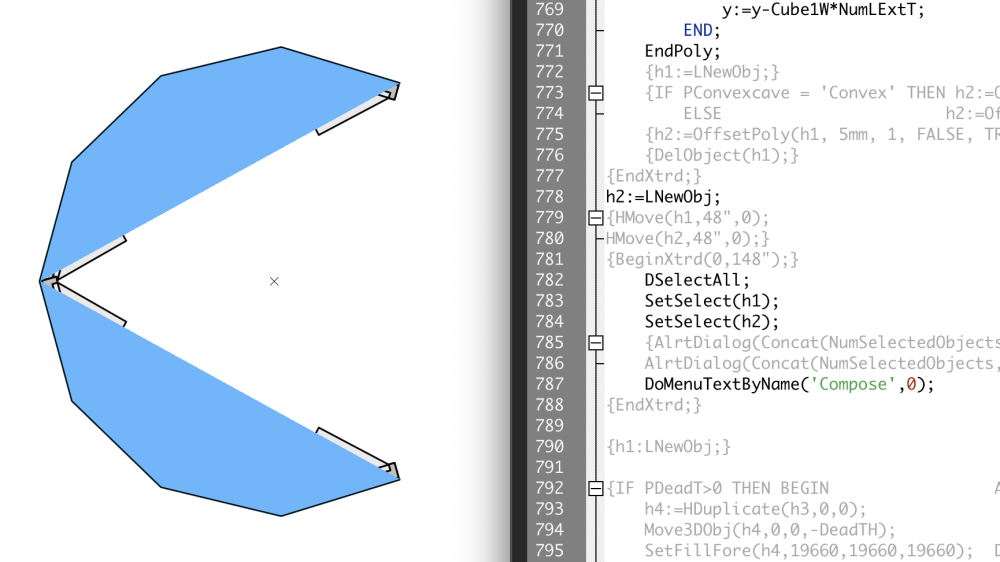-
Posts
107 -
Joined
-
Last visited
Reputation
7 NeutralPersonal Information
-
Occupation
Production Designer
-
Homepage
www.invnt.com
-
Hobbies
CAD
-
Location
United States
Recent Profile Visitors
1,610 profile views
-
I lost a couple hours on this issue as well. This thread saved me from pulling the rest of my hair out. Sure would be nice is VW could add that little note to the dialog box that pops up that the image also needs to be 72 dpi.
-
WINNER, WINNER, CHICKEN DINNER!!! Your right, I needed to define the object being extruded. It works now. Still not sure why the option using the BeginPoly/EndPoly with the HExtrude() afterwards didn't work, but I'm so happy to have found a solution, I don't really care. Big thank you for helping me think through this. Dave BeginXtrd(0',12'); BeginPoly; FOR i:=1 TO k DO BEGIN AddPoint(FullArrayPts[i].x,FullArrayPts[i].y); END; EndPoly; h1:=OffsetPoly(LNewObj,6", 1, TRUE, TRUE, 1, 0.1); EndXtrd;
-
I tried the BeginXtrd/EndXtrud idea, with GetCustomObjectPath() and OffsetPoly(), but nothing. The extruded poly was completely missing from the 2D and 3D views. There was no trace of it anywhere. I couldn't even get the BeginXtrd/EndXtrud to work by it's self which is weird, which makes me wonder if the script is corrupted or something. Dave BeginXtrd(144",240"); FOR i:=1 TO k DO BEGIN {LineTo(FullArrayPts[i].x,FullArrayPts[i].y);} AddPoint(FullArrayPts[i].x,FullArrayPts[i].y); END; EndXtrd; {h1:=GetCustomObjectPath(LNewObj); h2:=OffsetPoly(h1,6", 1, TRUE, TRUE, 1, 0.1);}
-
Sorry for all the replies. The reason why I abandoned the BeginXtrd/EndXtrud idea is because I need to do an OffsetPoly() command before the poly is extruded, and I don't think that's allowed within a BeginXtrd/EndXtrud command, and am unsure how I would do that after the BeginXtrd/EndXtrud command. Is it just a matter of using the GetCustomObjectPath() and then after getting a handle to the path, execute the OffsetPoly() command? Dave
-
Originally, I used BeginXtrd/EndExtrd, and calculated the vertices but abandoned that idea early on. Thinking about it now, I might be able to revisit that idea and use it with the FOR/TO command. I'll let you know how it goes. Dave
-
I even created a smaller test script and it work correctly. But for some reason it doesn't work in my bigger script. Dave PROCEDURE Test; VAR h1 : HANDLE; i : INTEGER; FullArrayPts: DYNARRAY[] OF POINT; BEGIN ALLOCATE FullArrayPts [1..5]; FullArrayPts[1].x:=0; FullArrayPts[1].y:=0; FullArrayPts[2].x:=5; FullArrayPts[2].y:=1; FullArrayPts[3].x:=9; FullArrayPts[3].y:=4; FullArrayPts[4].x:=12; FullArrayPts[4].y:=8; FullArrayPts[5].x:=13; FullArrayPts[5].y:=13; BeginPoly; FOR i:=1 TO 5 DO BEGIN AddPoint(FullArrayPts[i].x,FullArrayPts[i].y); END; EndPoly; {SetPolyClosed(LNewObj,TRUE);} h1:=HExtrude(LNewObj,4",144"); END; Run(Test);
-
Thank you for your comments, I'm switched the LineTo() command to AddPoint() command, and added a SetPolyClosed() command, but it still doesn't want to extrude. Thoughts? BeginPoly; FOR i:=1 TO k DO BEGIN {LineTo(FullArrayPts[i].x,FullArrayPts[i].y);} AddPoint(FullArrayPts[i].x,FullArrayPts[i].y); END; EndPoly; HMove(LNewObj,24",0); SetPolyClosed(LNewObj,TRUE); h1:=HExtrude(LNewObj,4",144");
-
I've moved my issue above to it's own thread so I don't highjack this thread.
-
Since I haven't received a response, I've rewritten my script to collect the points (vertices) so I can create one single polygon to extrude. The polygon is created, and I can move it, but I can't extrude it. Any ideas why? Is it possible my script is some how corrupted? Dave
-
I posted this a few days ago on a different thread but didn't get any response, so instead of highjacking that thread I thought it best to start a new one. The issue is very simple, I created two 2D polygons and wanted to combine them (using the menu command, Compose) and then extrude it. PROCEDURE Test; VAR poly1, poly2, polyOut : HANDLE; TF : BOOLEAN; BEGIN Poly( 0,0, 10,0, 10,10, 20,10 ); poly1 := LNewObj; Poly( 0,0, -10,0, -10,10, -20,10 ); poly2 := LNewObj; SetSelect(poly1); SetSelect(poly2); DoMenuTextByName('Compose',0); END; Run(Test); My apologies for dragging out this thread, but I can't figure out why I can't execute the example above in my larger script that I'm writing. I've tested and checked that I do have the two polygons selected (the blue objects in the screen shot below) that I want to combine, and that they are the only two things selected before executing the DoMenuTextByName('Compose',0) command. But for some reason, the two poly's don't combined. If I convert the PIO into a group and grab the two poly's myself, I can execute the Compose command and they combine correctly which proves to me that the two poly's are touching each other and can be combined. Hoping there might be someone smarter than I that can help me figure this out. Happy to provide the code or VWX file if that's helpful. Dave BeginPoly; ...... EndPoly; h1:=LNewObj; BeginPoly; ...... EndPoly; h2:=LNewObj; DSelectAll; SetSelect(h1); SetSelect(h2); DoMenuTextByName('Compose',0);
-
PROCEDURE Test; VAR poly1, poly2, polyOut : HANDLE; TF : BOOLEAN; BEGIN Poly( 0,0, 10,0, 10,10, 20,10 ); poly1 := LNewObj; Poly( 0,0, -10,0, -10,10, -20,10 ); poly2 := LNewObj; SetSelect(poly1); SetSelect(poly2); DoMenuTextByName('Compose',0); END; Run(Test); My apologies for dragging out this thread, but I can't figure out why I can't execute the example above in my larger script that I'm writing. I've tested and checked that I do have the two polygons (the blue objects in the screen shot below) selected that I want to combine, and that they are the only two things selected before executing the DoMenuTextByName('Compose',0) command. But for some reason, the two poly's don't combined. If I convert the PIO into a group and grab the two poly's myself, I can execute the Compose command and they combine correctly which proves to me that the two poly's are touching each other and can be combined. Hoping there might be someone smarter than I that can help me figure this out. Happy to provide the code or VWX file if that's helpful. Dave BeginPoly; ...... EndPoly; h1:=LNewObj; BeginPoly; ...... EndPoly; h2:=LNewObj; DSelectAll; SetSelect(h1); SetSelect(h2); DoMenuTextByName('Compose',0);
-
Jesse, thank you. I wasn't familiar with the those two similar commands DoMenuTextByName and CallToolByName. The AddSurface option gave me some intersecting geometry which didn't allow me to extrude the polyline after it was created, but the DoMenuTextByName option gave me exactly what i needed. REALLY REALLY appreciate your help. Dave
-
Using the example above, how do I use the CallToolByName('Compose') to join two polygons created within the script? Should be simple but what am I missing? PROCEDURE Test; VAR poly1, poly2, polyOut : HANDLE; TF : BOOLEAN; BEGIN Poly( 0,0, 10,0, 10,10, 20,10 ); poly1 := LNewObj; Poly( 0,0, -10,0, -10,10, -20,10 ); poly2 := LNewObj; SetSelect(poly1); SetSelect(poly2); TF:=CallToolByName('Compose'); END; Run(Test);
-
Thank you Jesse for moving me along. That's exactly what I needed. Dave
-
I apologize in advance for this simple question but I'm mentally stuck. I've created an object within a script using BeginXtrd/EndXtrud, Now I want to duplicate it and change the extruded height of the copy. How do I grab that variable and change it? My brain is simple not telling me what the command is to do that. BeginXtrd(5",10"); .... EndEtrd; Duplicate(0,0); { Command to change the extrude of the LNewObj } Dave









